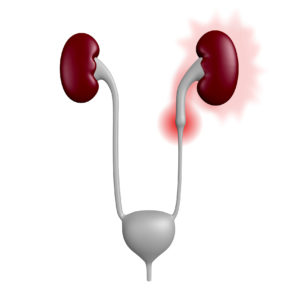Ureteral stents: What you need to know, courtesy of the Urology Care Foundation
Ureteral stents – why and how they are placed.
A ureteral stent is a small plastic tube that is placed inside a ureter to aid the flow of urine. As part of the urinary tract, the kidneys function to filter blood and process waste out of the body as urine. This urine passes through small tubes (the ureters) into the bladder before being expelled. Under certain circumstances, the ureters can become blocked inhibiting the flow of urine. Stent placement is a minimally invasive solution to allow urine to pass through to the bladder.
When are ureteral stents used?
Ureteral stents are commonly placed when a kidney stone becomes lodged in one of the ureters. In many cases, stones are small enough that they can easily pass through the ureters. However, when a large stone leaves the kidneys, it may become lodged. This blockage can cause severe pain and restrict urine flow. Additionally, ureteral stones may form within the ureters. These stones can also become large enough to create a blockage.
Likewise, ureters can be blocked by a benign or malignant tumor. Ureteral stent placement can be used to bypass this growth. When surgery is required, a stent may be used (after surgery) to keep the ureters open during the healing process.
How are ureteral stents placed?
Ureteral stent placement is a minimally invasive procedure that is typically performed in a surgery center or hospital. The stent itself is placed over a long, thin wire that is fed through the urethra from the bladder to a kidney. This wire is temporarily held into place by a small coil on each end of the wire – one end remains in the bladder, the other end remains in a kidney. This wire is fed through the urinary tract using a cystoscope. Once in place, the stent (tube) is fed over the wire into the ureter where the blockage is located. Prior to stent placement, your urologist will discuss both pre- and post-op instructions.
Following ureteral stent placement
After stent placement patients may experience various aftereffects. Typically these may include:
- Discomfort.
- A pulling sensation while urinating.
- Urinary frequency.
- Urinary urgency.
- Hematuria – blood in the urine.
- Pelvic pain.
Patients should notify their physician if these symptoms are extreme or ongoing. Doctors should also be notified if patients feel that they are running a fever, are experiencing chills, have cloudy, dark, or foul smelling urine, or experiencing pain around the kidneys. Additionally, if patients experience a burning sensation while urinating, they should contact their doctor.
Patients will return to our office when the surgeon specifies for stent removal. If there is a string, it will be pulled in the office. If there is not a visible string, it will be removed via snare or cystoscopy procedure.
For more information about ureteral stent placement, contact Urology Austin to schedule an appointment with one of our providers.

